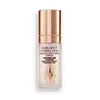What's inside
What's inside
 Key Ingredients
Key Ingredients

 Benefits
Benefits

 Concerns
Concerns

 Ingredients Side-by-side
Ingredients Side-by-side

Water
Skin ConditioningSqualane
EmollientC13-15 Alkane
SolventGlycerin
HumectantXylitol
HumectantPentylene Glycol
Skin ConditioningPolyquaternium-37
Hydrogenated Phosphatidylcholine
EmulsifyingPhytosphingosine
Skin ConditioningPhytosterols
Skin ConditioningNiacinamide
Smoothing3-O-Ethyl Ascorbic Acid
Skin ConditioningXanthophylls
Skin ConditioningPanthenol
Skin ConditioningHyaluronic Acid
HumectantTocopherol
AntioxidantBetula Alba Bark Extract
MaskingTranexamic Acid
AstringentPhytosteryl Isostearate
Skin ConditioningBeta-Sitosterol
Emulsion StabilisingSodium Beta-Sitosteryl Sulfate
Skin ConditioningTamarindus Indica Seed Gum
Emulsion StabilisingPhenylpropanol
MaskingCaprylyl Glycol
EmollientSilica
AbrasiveCetyl-Pg Hydroxyethyl Palmitamide
Skin ConditioningLysolecithin
EmulsifyingSorbitan Caprylate
EmulsifyingLecithin
EmollientPentaerythrityl Tetra-Di-T-Butyl Hydroxyhydrocinnamate
AntioxidantPropanediol
SolventOctyldodecanol
EmollientParfum
MaskingHydroxyacetophenone
AntioxidantPelargonium Graveolens Flower Oil
MaskingCitrus Limon Peel Oil
MaskingLimonene
PerfumingCitrus Aurantium Dulcis Peel Oil
MaskingCitrus Sinensis Peel Oil Expressed
PerfumingCitrus Aurantium Bergamia Peel Oil
Cananga Odorata Flower Extract
PerfumingPogostemon Cablin Leaf Oil
MaskingGeraniol
PerfumingCitronellol
PerfumingLinalool
PerfumingCitral
PerfumingWater, Squalane, C13-15 Alkane, Glycerin, Xylitol, Pentylene Glycol, Polyquaternium-37, Hydrogenated Phosphatidylcholine, Phytosphingosine, Phytosterols, Niacinamide, 3-O-Ethyl Ascorbic Acid, Xanthophylls, Panthenol, Hyaluronic Acid, Tocopherol, Betula Alba Bark Extract, Tranexamic Acid, Phytosteryl Isostearate, Beta-Sitosterol, Sodium Beta-Sitosteryl Sulfate, Tamarindus Indica Seed Gum, Phenylpropanol, Caprylyl Glycol, Silica, Cetyl-Pg Hydroxyethyl Palmitamide, Lysolecithin, Sorbitan Caprylate, Lecithin, Pentaerythrityl Tetra-Di-T-Butyl Hydroxyhydrocinnamate, Propanediol, Octyldodecanol, Parfum, Hydroxyacetophenone, Pelargonium Graveolens Flower Oil, Citrus Limon Peel Oil, Limonene, Citrus Aurantium Dulcis Peel Oil, Citrus Sinensis Peel Oil Expressed, Citrus Aurantium Bergamia Peel Oil, Cananga Odorata Flower Extract, Pogostemon Cablin Leaf Oil, Geraniol, Citronellol, Linalool, Citral
Water
Skin ConditioningPropylene Glycol
HumectantGlycerin
HumectantAlcohol Denat.
AntimicrobialPEG/PPG/Polybutylene Glycol-8/5/3 Glycerin
HumectantHydroxypropyl Tetrahydropyrantriol
Skin Conditioning3-O-Ethyl Ascorbic Acid
Skin ConditioningPPG-6-Decyltetradeceth-30
EmulsifyingPhenoxyethanol
PreservativeSalicylic Acid
MaskingXanthan Gum
EmulsifyingHydroxyethylcellulose
Emulsion StabilisingPotassium Hydroxide
BufferingCitric Acid
BufferingSodium Citrate
BufferingTocopheryl Acetate
AntioxidantLavandula Angustifolia Oil
MaskingDisodium EDTA
Adenosine
Skin ConditioningLinalool
PerfumingButylene Glycol
HumectantTocopherol
AntioxidantCitrus Aurantium Tachibana Peel Extract
HumectantPaeonia Suffruticosa Root Extract
Skin ProtectingWater, Propylene Glycol, Glycerin, Alcohol Denat., PEG/PPG/Polybutylene Glycol-8/5/3 Glycerin, Hydroxypropyl Tetrahydropyrantriol, 3-O-Ethyl Ascorbic Acid, PPG-6-Decyltetradeceth-30, Phenoxyethanol, Salicylic Acid, Xanthan Gum, Hydroxyethylcellulose, Potassium Hydroxide, Citric Acid, Sodium Citrate, Tocopheryl Acetate, Lavandula Angustifolia Oil, Disodium EDTA, Adenosine, Linalool, Butylene Glycol, Tocopherol, Citrus Aurantium Tachibana Peel Extract, Paeonia Suffruticosa Root Extract
 Reviews
Reviews

Ingredients Explained
These ingredients are found in both products.
Ingredients higher up in an ingredient list are typically present in a larger amount.
You might know this ingredient as Ethyl Ascorbic Acid, a more stable version of ascorbic acid.
Like other types of vitamin C, this ingredient has many benefits including reducing wrinkles, skin soothing, dark spot fading, and fighting against free radicals.
3-O-Ethyl Ascorbic Acid interferes with the process of skin darkening, helping to reduce hyperpigmentation. It also encourages the skin to produce more collagen.
Once applied, 3-O-Ethyl Ascorbic Acid is converted to Vitamin C deeper in the skin's layers. This process is slow but makes this ingredient more tolerable for skin.
The optimum pH range for this ingredient is 4 - 5.5
Learn more about 3-O-Ethyl Ascorbic AcidGlycerin is already naturally found in your skin. It helps moisturize and protect your skin.
A study from 2016 found glycerin to be more effective as a humectant than AHAs and hyaluronic acid.
As a humectant, it helps the skin stay hydrated by pulling moisture to your skin. The low molecular weight of glycerin allows it to pull moisture into the deeper layers of your skin.
Hydrated skin improves your skin barrier; Your skin barrier helps protect against irritants and bacteria.
Glycerin has also been found to have antimicrobial and antiviral properties. Due to these properties, glycerin is often used in wound and burn treatments.
In cosmetics, glycerin is usually derived from plants such as soybean or palm. However, it can also be sourced from animals, such as tallow or animal fat.
This ingredient is organic, colorless, odorless, and non-toxic.
Glycerin is the name for this ingredient in American English. British English uses Glycerol/Glycerine.
Learn more about GlycerinLinalool is a fragrance and helps add scent to products. It's derived from common plants such as cinnamon, mint, citrus, and lavender.
Like Limonene, this ingredient oxidizes when exposed to air. Oxidized linalool can cause allergies and skin sensitivity.
This ingredient has a scent that is floral, spicy tropical, and citrus-like.
Learn more about LinaloolTocopherol (also known as Vitamin E) is a common antioxidant used to help protect the skin from free-radicals and strengthen the skin barrier. It's also fat soluble - this means our skin is great at absorbing it.
Vitamin E also helps keep your natural skin lipids healthy. Your lipid skin barrier naturally consists of lipids, ceramides, and fatty acids. Vitamin E offers extra protection for your skin’s lipid barrier, keeping your skin healthy and nourished.
Another benefit is a bit of UV protection. Vitamin E helps reduce the damage caused by UVB rays. (It should not replace your sunscreen). Combining it with Vitamin C can decrease sunburned cells and hyperpigmentation after UV exposure.
You might have noticed Vitamin E + C often paired together. This is because it is great at stabilizing Vitamin C. Using the two together helps increase the effectiveness of both ingredients.
There are often claims that Vitamin E can reduce/prevent scarring, but these claims haven't been confirmed by scientific research.
Learn more about TocopherolWater. It's the most common cosmetic ingredient of all. You'll usually see it at the top of ingredient lists, meaning that it makes up the largest part of the product.
So why is it so popular? Water most often acts as a solvent - this means that it helps dissolve other ingredients into the formulation.
You'll also recognize water as that liquid we all need to stay alive. If you see this, drink a glass of water. Stay hydrated!
Learn more about Water